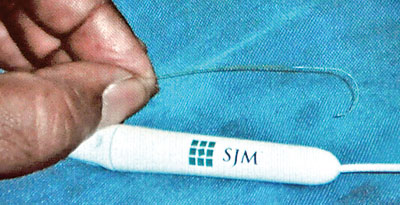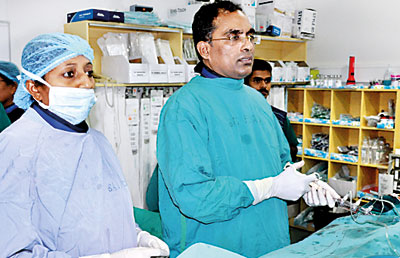Are you sure you will not faint? You look pale, sure the sight of a little blood won’t affect you, asks Consultant Interventional Cardiologist Dr. S. Mithrakumar, as we peer closely at a patient.
Cardiac interventions, in simple terms, the diagnosis and treatment of blocks in vital blood vessels connected to the heart being taken to a completely different level, are what we have come to witness.
The latest “boy on the block”, who not only allows for accurate diagnosis of the percentage of the block in the blood vessels but also guides Cardiologists in their decision whether to insert stents or not, is the Fractional Flow Reserve (FFR) machine. The build-up of plaque in vessels hinders the flow of blood and increases the risk of heart attacks and death.
 |
| The latest “boy on the block” |
 |
| Dr. Mithrakumar prepares for an angiogram including an FFR procedure |
To see this state-of-the-art machine, which looks nothing more than a computer monitor with a set of tubes, doing its wonder work, the three-member team of the Sunday Times, weighted down not only by gowns padded with metal but also neck-guards to ward off radioactive rays, is in the Cath Lab of Durdans Hospital. For this is the only hospital where the FFR machine is available, imported just a few months ago.
Laughing out loud when we say that we have seen open-heart surgery and all the blood associated with it and referring to such surgery as “archaic”, Dr. Mithrakumar leads us into the world of interventional cardiology while also advising the patient who is conscious to, “husma athulata arang poddak nathara karranna”. (Take a breath and hold for awhile.)
Explaining the simplicity and advantages of this procedure, Dr. Mithrakumar says it can be done as an outpatient procedure. Under the FFR procedure done during an angiogram, a very thin guide wire with a black tip inserted in a diagnostic catheter is sent through the radial artery (in the wrist), he says, adding that earlier the femoral artery (in the groin) was used. There is less trauma when using the radial artery, while it is also less painful.
An angiogram, according to this Interventional Cardiologist who has performed more than 7,000 radial angiograms, is an X-ray that uses a special iodine dye and camera (fluoroscopy) to take pictures of the blood flow in an artery or a vein which can be seen on a computer monitor.
Enhanced by the FFR, the special wire-guided sensor accesses the block and measures the flow and pressure of the blood, allowing a decision to be taken whether stenting should be performed or not, on accurate findings, says Dr. Mithrakumar, pointing out that earlier the decision would have depended on the Cardiologist visualizing it from the images produced by the angiogram and estimating the block percentage.
“This is not entirely accurate since there can be an under-estimation or over-estimation,” he says, underscoring the fact that until the FFR was introduced there was no consistency in evaluating the exact severity of the narrowing of the vessels. Visually a block may seem to be serious, with doctors estimating a high percentage of about 80%, but when screened by the FFR it may actually be only about 30-40%. With stenting being done only on 60% or higher blocks, not only does the FFR cut down the risk of unnecessary stent-insertion but also of not placing a stent when needed.
Citing the case of a patient who had four blocks and was deemed necessary to have stenting for all, Dr. Mithrakumar says the FFR clearly indicated the need for only two.
Usually if the lesion (block) is about 50-60%, the patient is treated with medication and stenting carried out only if the block percentage is higher, he says.
The FFR also helps measure the pressure at a block not only proximally (nearer to the point of origin) but also distally (away from the point of origin), the Sunday Times learns. So even if the eye is fooled, the FFR will indicate whether a stent is required, if there is a severe restriction of the blood flow.
The added advantages are that the FFR is also able to overcome abnormal anatomies and allow the Interventional Cardiologist to view beyond them, he says, explaining that about 1 in 50 patients has an abnormal aortic arch.
The expertise and skill of the Interventional Cardiologist also comes into play here and it takes only about five minutes for Dr. Mithrakumar to carry out the procedure, with the patient walking out of the Cath Lab soon after.
FFR is the “most successful scientific evaluation” before stenting, says Dr. Mithrakumar, pointing out that no guesswork is involved. “The patient gets evidence-based medical treatment while we are moving towards perfection in the treatment of obstructive coronary heart disease.” |



